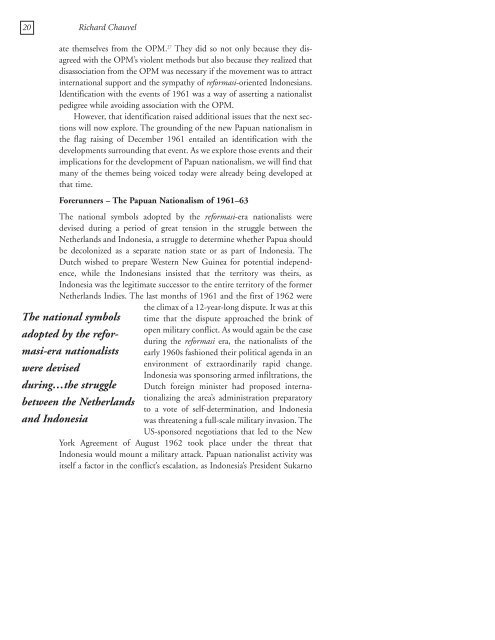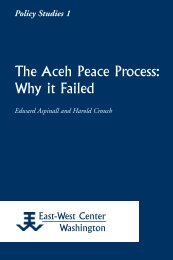Constructing Papuan Nationalism: History, Ethnicity ... - ScholarSpace
Constructing Papuan Nationalism: History, Ethnicity ... - ScholarSpace
Constructing Papuan Nationalism: History, Ethnicity ... - ScholarSpace
- No tags were found...
Create successful ePaper yourself
Turn your PDF publications into a flip-book with our unique Google optimized e-Paper software.
20 Richard Chauvelate themselves from the OPM. 27 They did so not only because they disagreedwith the OPM’s violent methods but also because they realized thatdisassociation from the OPM was necessary if the movement was to attractinternational support and the sympathy of reformasi-oriented Indonesians.Identification with the events of 1961 was a way of asserting a nationalistpedigree while avoiding association with the OPM.However, that identification raised additional issues that the next sectionswill now explore. The grounding of the new <strong>Papuan</strong> nationalism inthe flag raising of December 1961 entailed an identification with thedevelopments surrounding that event. As we explore those events and theirimplications for the development of <strong>Papuan</strong> nationalism, we will find thatmany of the themes being voiced today were already being developed atthat time.Forerunners – The <strong>Papuan</strong> <strong>Nationalism</strong> of 1961–63The national symbols adopted by the reformasi-era nationalists weredevised during a period of great tension in the struggle between theNetherlands and Indonesia, a struggle to determine whether Papua shouldbe decolonized as a separate nation state or as part of Indonesia. TheDutch wished to prepare Western New Guinea for potential independence,while the Indonesians insisted that the territory was theirs, asIndonesia was the legitimate successor to the entire territory of the formerNetherlands Indies. The last months of 1961 and the first of 1962 werethe climax of a 12-year-long dispute. It was at thistime that the dispute approached the brink ofopen military conflict. As would again be the caseduring the reformasi era, the nationalists of theearly 1960s fashioned their political agenda in anenvironment of extraordinarily rapid change.Indonesia was sponsoring armed infiltrations, theDutch foreign minister had proposed internationalizingthe area’s administration preparatoryto a vote of self-determination, and Indonesiawas threatening a full-scale military invasion. TheUS-sponsored negotiations that led to the NewYork Agreement of August 1962 took place under the threat thatIndonesia would mount a military attack. <strong>Papuan</strong> nationalist activity wasitself a factor in the conflict’s escalation, as Indonesia’s President SukarnoThe national symbolsadopted by the reformasi-eranationalistswere devisedduring…the strugglebetween the Netherlandsand Indonesia
















